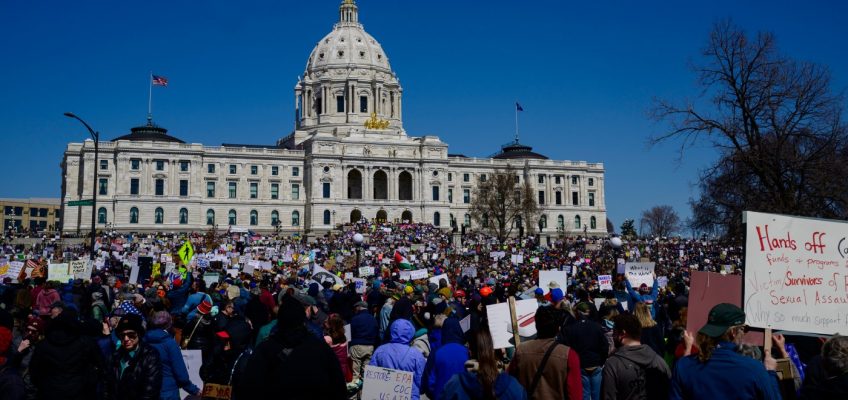It’s still difficult to guess who will be the Minnesota Vikings’ backup quarterback to J.J. McCarthy next season. But it’s definitely not going to be Aaron Rodgers and it’s unlikely to be Kirk Cousins.
There’s a 99 percent chance that Rodgers winds up with the Steelers, and for Cousins the most likely choice is the Browns.
That leaves Ryan Tannehill, 36, who made nearly $200 million during an 11-year NFL career and now lives happily in Nashville, Tenn.; Joe Flacco, 40, and Drew Lock, 28, among considerations.
Tannehill, who sat out last season, is 6-feet-4 and has a strong arm, which Vikings coach Kevin O’Connell values.
The Vikings aren’t expected to make their choice for about a month.
>> It’s been obvious the Vikings hope McCarthy, 22, can be their starter. Now it’s a question whether they can find a suitable backup if something happens with McCarthy, who missed last season following two right knee procedures.
>> Trey Lance, the Marshall High (Minn.) grad, There was no chance with the Vikings even though he’s expected to sign a free agent deal with the Chargers. Lance, 24, received a guaranteed $34.1 million contract from the 49ers four years ago.
>> It was 2006. Niko Medved was 32 years old. Gophers men’s basketball coach Dan Monson recalled interviewing him with top assistant Jim Molinari for an assistant job.
“I remember Molinari saying we’ve got to keep him here — he’s a superstar, he’s a loyal Gopher and he loves it here,” Monson told the Pioneer Press. “So we found him a few dollars from some auxiliary money to just be part of the staff. It was a win for him and a win for us.”
Medved, 51, the Roseville Area and Minnesota grad, last week was hired as head Gophers coach with an $18 million, six-year contract.
“In the interview, you could see he was sharp, had a great presence about him pretty even keeled, didn’t get too high or too low — and he was young,” Monson said.
Medved’s Gophers deal averages $3 million a year, with an annual supplemental payment of $100,000.
“More than they paid me,” Monson said with a laugh.
Monson, 63, is head coach at Eastern Michigan.
>> It was 28 years ago. Tom Lehman was the No. 1-ranked golfer in the world. Last weekend in Palm Desert, Calif., Lehman, 66, was back playing a full schedule on the PGA Champions Tour. He is as competitive as ever.
“My game is the best it’s been in a few years,” the former Gopher from Alexandria told the Pioneer Press while preparing to play in the Galleri Classic. “I‘m hitting it a lot better, a little bit longer, hitting it solid. I just need to find a way to get that ball to go into the hole.”
Lehman remains the only golfer in history to be ranked No. 1 on the PGA Tour, No. 1 on the Champions Tour and No.1 on the Ben Hogan Tour, now the Korn Ferry Tour. Some people feel strongly that the 1996 British Open champion and 2006 USA Ryder Cup captain qualifies for the World Golf Hall of Fame.
How long does Lehman intend to play on tour?
“I really enjoy the preparation that goes into golf, but I don’t like to play poorly,” he said. “My game was lousy the last couple of years, but if it can get better again and start getting better results, I’ll maybe play a little bit longer.”
He’s won 12 times on the Champions Tour. Can he win again?
“I played with Ernie Els and he told me, ‘I think you can still win the way you hit it,’ so that was a nice compliment. He didn’t have to say it.
“It’s all about the putting. If I can start to roll it and get the ball to start dropping, I think I can still be competitive.”
As for his putting, Lehman said he needs to relax.
“The older I get, the more anxious I get on the green,” he said. “If I can find a way to relax and be comfortable, then I putt well. But if I have anxiety, then I don’t. I’ve been thinking about switching it up with a whole different putting style, maybe going with the long putter, doing something totally different.”
>> One entrepreneur has offered private home accommodations for three nights near Augusta, Ga., with badges for four people for Saturday and Sunday at the Masters, which begins on Thursday, for $31,900.
>> Had Gophers golfer Isabella McCauley not missed the cut by one shot in the Augusta National Women’s Amateur tournament after a second-round 69 last week, she would have advanced to the finals at the storied course with a chance to win and earn a spot in four of the five LPGA majors this year.
>> Former NY Rangers GM Glen Sather last week in Palm Desert, Calif., on why he named Cretin-Derham Hall grad Ryan McDonagh his captain at age 25: “He has common sense, leadership and is a great player.” McDonagh, now of the Lightning, was honored last weekend in Tampa for playing in his 1,000th NHL game.
Meanwhile, that was hockey royalty — Sather, who as GM built five Stanley Cup champions with the Oilers, and former North Stars GM Lou Nanne — lunching in Palm Desert last week.
>> Woodbury’s Max Meyer, 26, the former Gophers pitcher back in the major leagues with the Marlins, Is recovered after Tommy John surgery nearly two years ago and has added a “sweeper” breaking pitch to his fastball that touches 98-mph. He’s stuck out 15 in 11 2/3 innings in two starts this season and is playing for $800,000. The Marlins have a major league-low $70 million payroll.
>> Mounds View’s Sam Hentges, 28, the 6-6 left-hander with a 95-mph fastball out for the season with the Cleveland Guardians after shoulder surgery, still gets his $1.4 million salary this year.
>> The Twins will win 83 games, finishing third in their division, and miss the playoffs, per Sports Illustrated.
Gophers football nets commitment from lineman Gavin Meier over Badgers, others
What Niko Medved and P.J. Fleck talked about during hiring process
Gophers football: Quarterback Drake Lindsey will need to earn starting spot
Gophers gain commitment from Arizona prep receiver Rico Blassingame
Gophers men’s basketball: Two more players to enter NCAA transfer portal
>> That was former Twin Frank Viola, wife Kathy and extended family in town the other day to celebrate the 100th birthday of Kathy’s aunt Evelyn, who is from St. Paul. During their stay, the Violas’ took their grandkids to Target Field to learn about their 1987 World Series MVP grandpa.
This season, Viola, 64, who was the American League 1988 Cy Young Award winner, is pitching coach for the High Point (N.C.) Rockers in the Atlantic League.
>> More than 100 well-wishers turned up at Macalester College recently for a celebration of life for the beloved mother of Andy Bischoff, the former Cretin-Derham Hall football assistant who has gone on to be running game coordinator for the LA Chargers.
>> After three years of planning, former Gophers-Vikings linebacker Mark Dusbabek, who is chief rules referee and analyst for CBS-NBC TV’s coverage of the PGA Tour, has completed a video review center and broadcast from it during the Players Championship won by Rory McIlroy.
Dusbabek, 60, is busy working on more technology advances while continuing his on-air work.
>> Two-time world heavyweight boxer George Foreman died the other day at age 76. Late Minnesota boxer Scott LeDoux, who fought a handful of ex-world heavyweight champions, including Foreman, said the hardest puncher, by far, he faced was Foreman.
“Like getting hit with a jackhammer,” LeDoux said.
>> Catholic Athletic Association Hall of Fame electees are Greg Lendway, Ralph Norusis and Emmy Treacy Springer. Inductions are April 30 at Mendakota Country Club.
>> Electees to the Mancini’s St. Paul Sports Hall of Fame are Les Larson for hockey, Matt Vanda for boxing, Paul Weinberg and Tony Stone for baseball, Lou Raiola for football and Casey O’Brien for a special award. Inductions are May 12 at the Char House.
>> That was Dave Lee’s 51st year of broadcasting prep state tournament basketball games, including 12 recently on Ch. 45-TV. “It’s still a kick,” said Lee, the former WCCO-AM icon.
DON’T PRINT THAT
>> It remains uncertain whether the Minnesota Twins, who announced in October they would explore selling the team, will be able to find a suitable buyer.
Asked recently by the Pioneer Press if there’s a chance the Twins won’t be sold this year after all, Twins owner Jim Pohlad said “there’s always a chance.”
>> Before pocketing $1.5 billion for selling the Timberwolves-Lynx, Glen Taylor’s wealth was estimated at $3 billion, per Forbes’ new valuations this month. He could easily afford to buy the Twins.
>> Pssst: Kevin Garnett returning to the Timberwolves’ front office as the face of the team now that Taylor is relinquishing ownership has been done for more than a year, assuming new ownership.
>> Look for ex-Gopher Pharrel Payne to leave Texas A&M for Maryland for a $1.5 million NIL deal.
>> Count on it: After prolonged back and forth negotiating, Wild star Karill Kaprizov this summer will sign an eight-year contract extension for at least $16 million a season.
>> The Gophers’ firing of men’s basketball coach Ben Johnson at midnight on March 13 after a season-ending loss at Northwestern recalls the USC firing of Bloomington Jefferson grad Lane Kiffin as football coach in 2013. Kiffin was fired at 3 a.m. at Los Angeles International Airport after returning home from a loss at Arizona State, and the team bus back to campus took off without him.
>> Just as cold, the Gophers had Eric Musselman scheduled to interview in person with then-athletics director Norwood Teague in Naples, Fla., in 2013 for the head basketball coaching job. But then Richard Pitino was hired, and no one from the Gophers even bothered to inform Musselman, who was next on the list and left waiting in Naples.
>> That was Johnson and Cleveland Cavs head coach B.J. Bickerstaff, the former Gopher, dining at J.D. Hoyt’s in Minneapolis Saturday evening last week.
>> Cam Christie, 19, who left the Gophers to become a second-round draft pick of the LA Clippers and $3.1 million guaranteed contract, is averaging 18.2 points and 4.4 rebounds in the NBA G League.
>> Daniel Freitag, the former Bloomington Jefferson career scoring leader who was used sparingly as a freshman guard at Wisconsin this season, has entered the NCAA transfer portal.
>> The University of St. Thomas’ two leading men’s basketball scorers Miles Barnstable and Kendall Blue are entering the transfer portal.
>> Look for Andrew Rohde, who left the Tommies two years ago for a $150,000 per season NIL deal with Virginia, to transfer to home state Wisconsin.
>> A little birdie said the Gophers men’s basketball name, image and likeness (NIL) budget this season —lowest in the Big Ten — was in the $700,000 range, of which Dawson Garcia got $500,000.
>> Orono’s Yale-bound Nolan Groves, who the last two seasons scored more than 50 points in each of four games, including 57 against St. Louis Park, received no interest from the Gophers although he hoped he would. In an 87-71 state tournament opening victory over DeLaSalle, the 6-5 shooting guard scored 44 points with 11 rebounds.
Groves last week was named the Minnesota Gatorade player of the year.
>> A little birdie says 6-8 Clemson-bound Chase Thompson, who led Alexandria to the 3A state boys basketball championship, has a NIL deal with the Tigers in the $1.5 million range.
>> Tre Holloman, the Cretin-Derham grad, is hearing from multiple schools since leaving Michigan State last week for his senior season, but has received only casual interest from the Gophers.
>> Although she’s just a high school junior, look for Providence Academy’s 5-8 guard Maddyn Greenway to receive a colossal NIL deal for committing to Kentucky.
>> The date for the Vikings at Seahawks game next season, presumably featuring QBs J.J. McCarthy against ex-Viking Sam Darnold, will be released in five weeks.
>> There’s buzz that the Vikings will play a road game in Ireland against the Steelers this year.
>> It will depend on the amount of years, but a new naming rights deal for the Gophers Williams Arena will be worth slightly more than $1million a year, the average cost of a decent starting Division I quarterback.
>> Karl-Anthony Towns, traded to the Knicks in October, now has his Orono home on the market for $5.5 million after buying it for $4.52 million in 2020.
>> No doubt the Vikings, who currently have just four picks for the upcoming NFL draft, will trade down from their No. 24 in the first round to acquire more picks.
>> For $250, Vikings season ticket holders can experience the NFL draft on April 24 at U.S. Bank Stadium with various perks.
Hustle plays by Byron Buxton, Christian Vazquez pay off for Twins
Jose Miranda supplies the power, Bailey Ober the grit in win over Astros
Lynx legends Sylvia Fowles, Maya Moore selected for Basketball Hall of Fame induction
NHL scoring record: Gretzy was there for Ovechkin long before Friday
Wild loss costly on many levels as playoff position now in real danger
Overheard
>> Gophers athletics director Mark Coyle four years ago on the hiring on men’s basketball coach Ben Johnson: “Ben is a proven coach who is ready to lead his own program. He has earned this opportunity and is a tremendous teacher, recruiter and relationship builder. I am thrilled for him to lead his alma mater, and I am excited for the future of our men’s basketball program.”
Coyle two weeks ago on the hiring of Niko Medved after firing Johnson: “This is an exciting day for our program, our University and our state. Niko is a Minnesota alum with a proven head coaching track record. He has had success everywhere he has been, and we look forward to him leading out men’s basketball program at his alma mater.”




